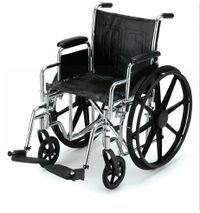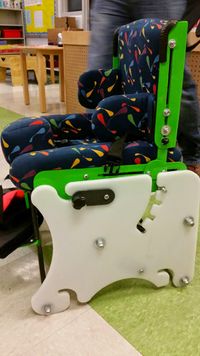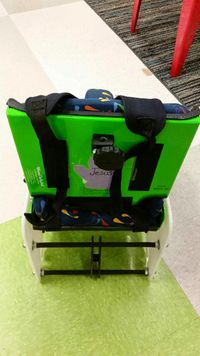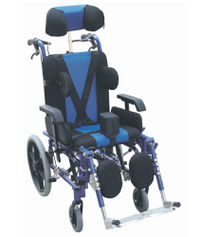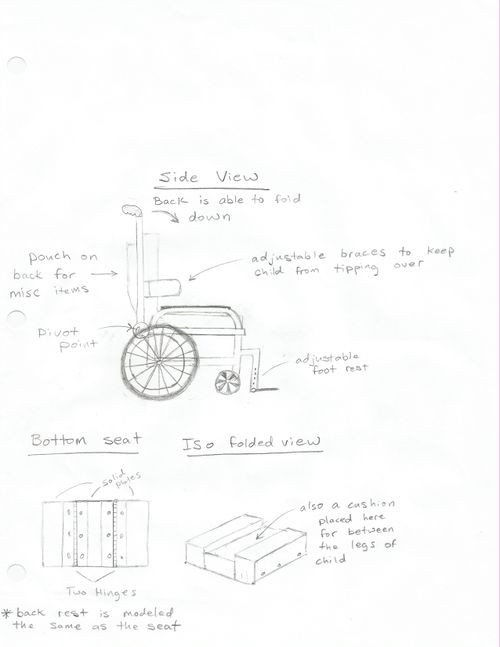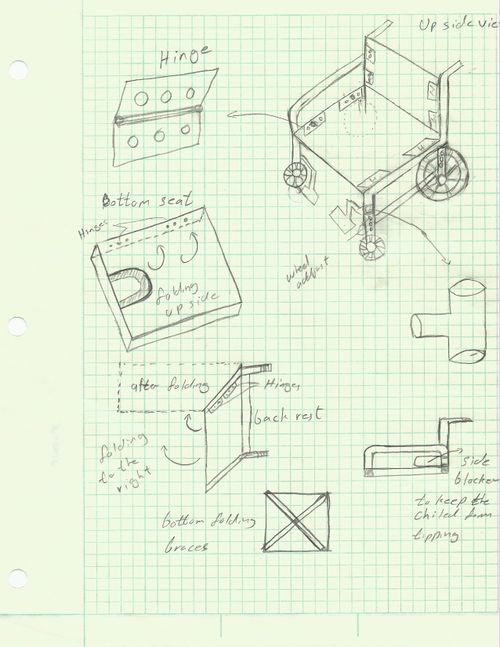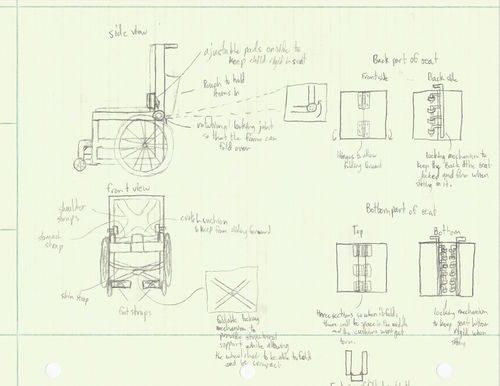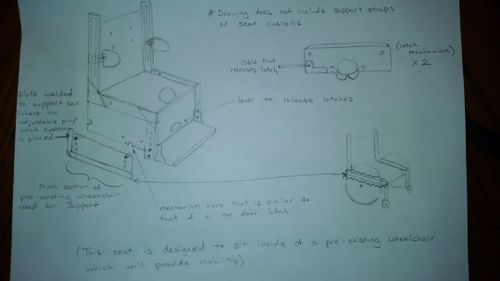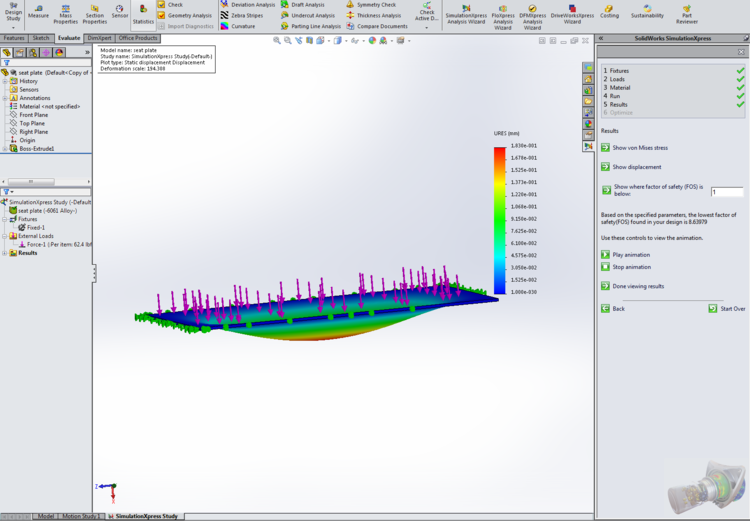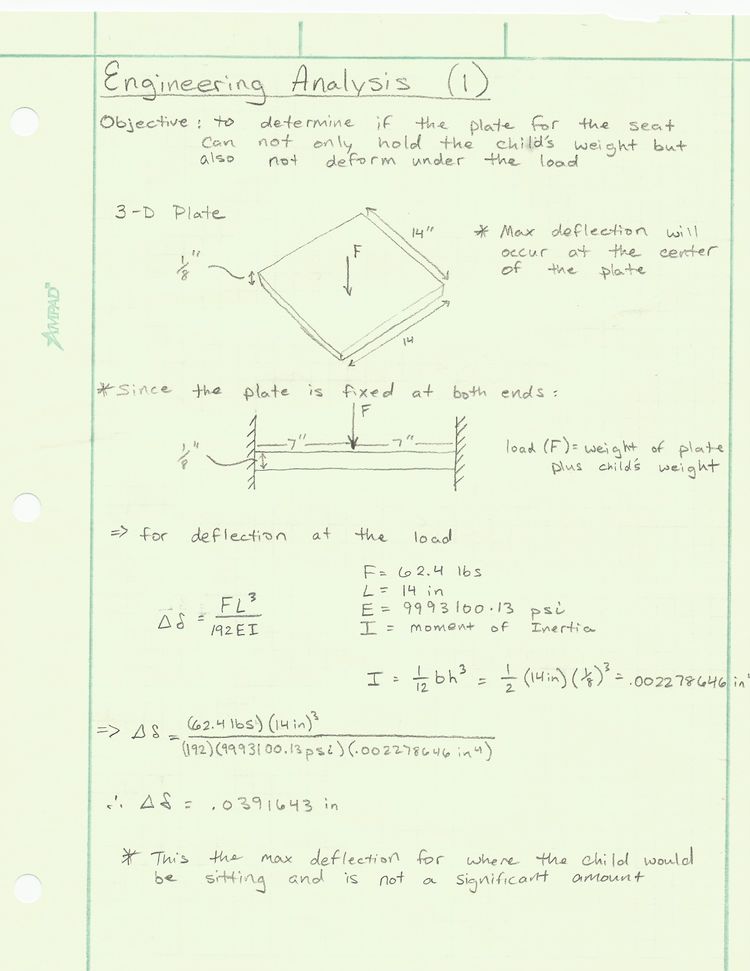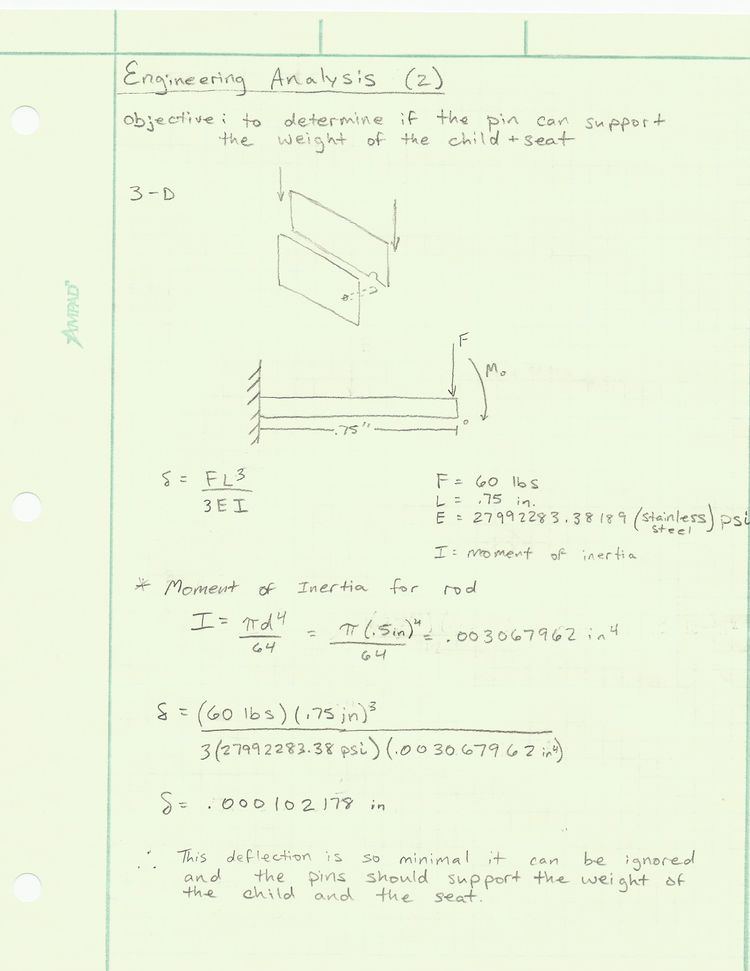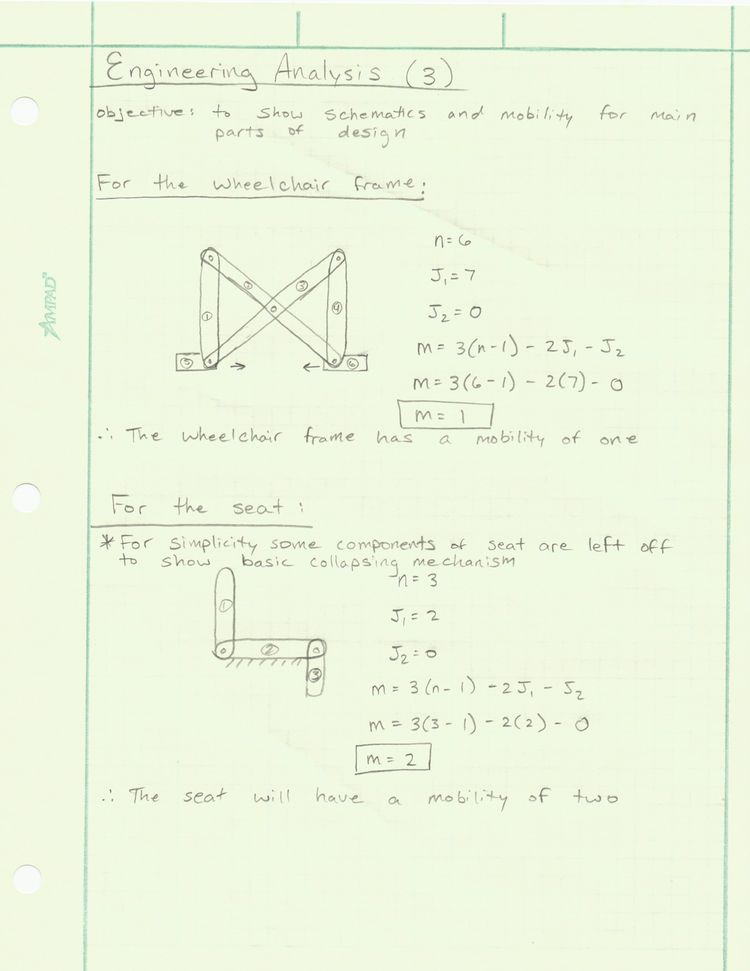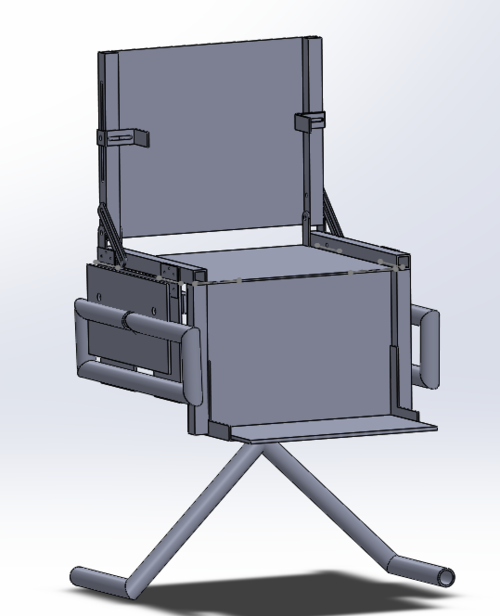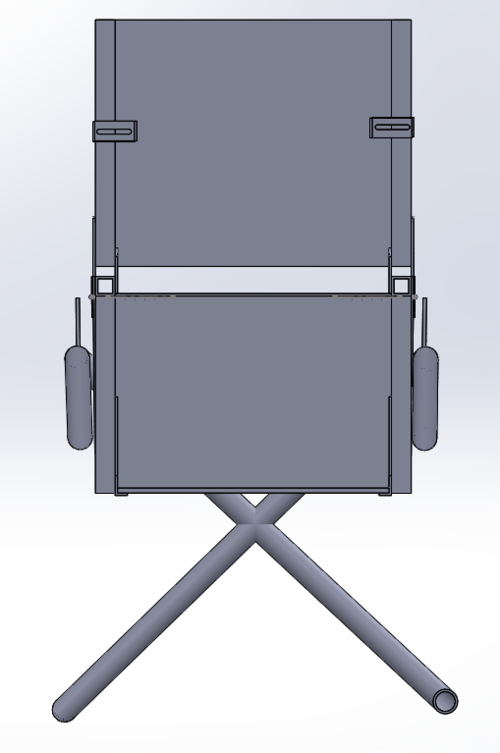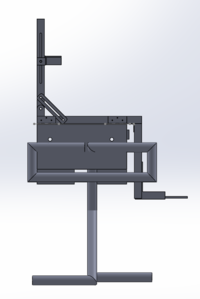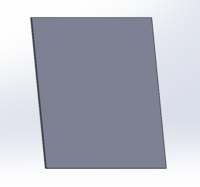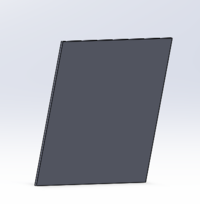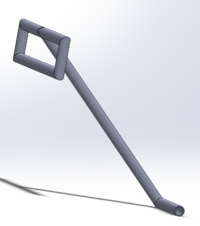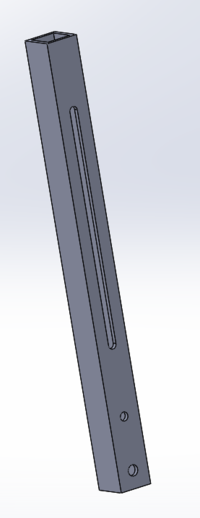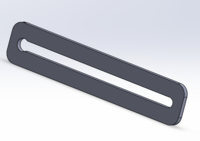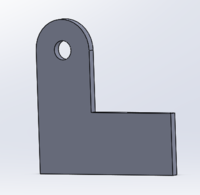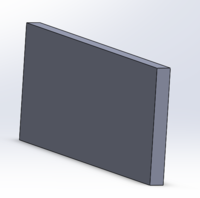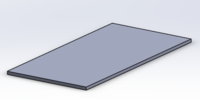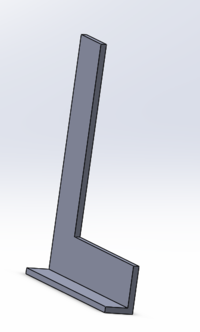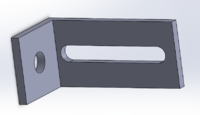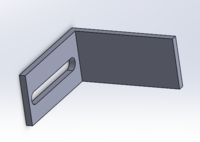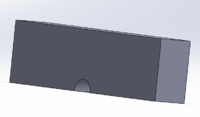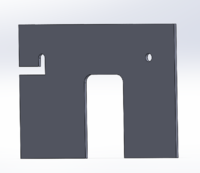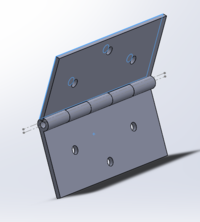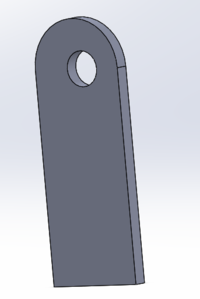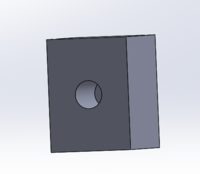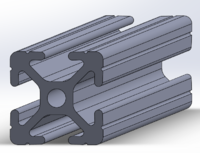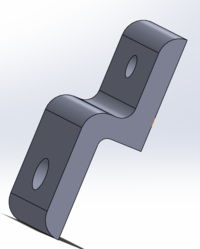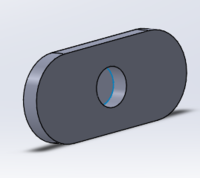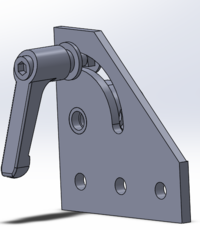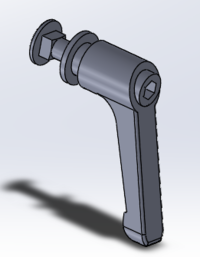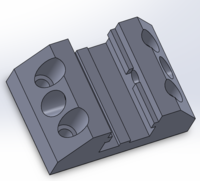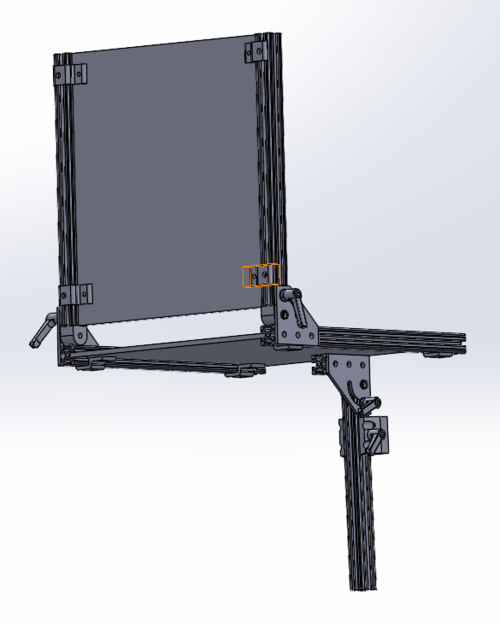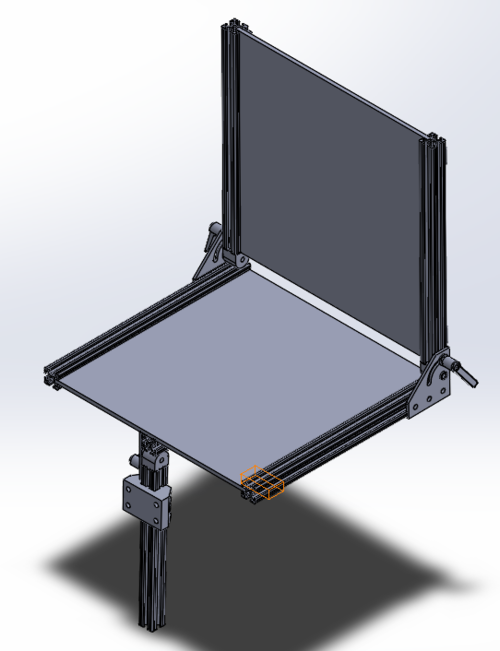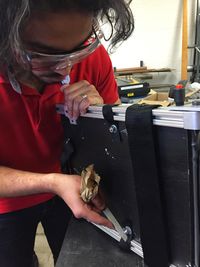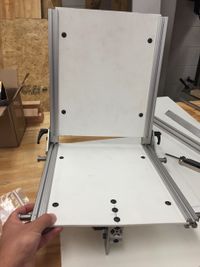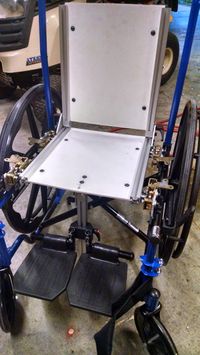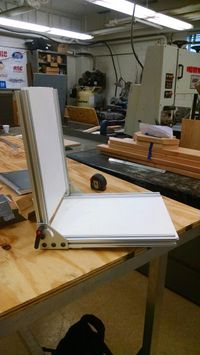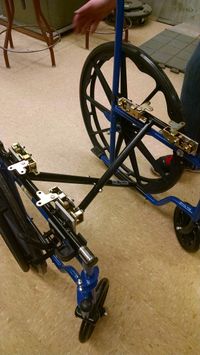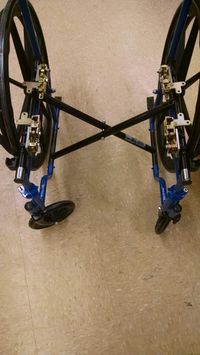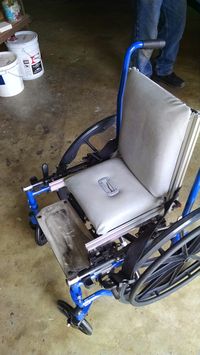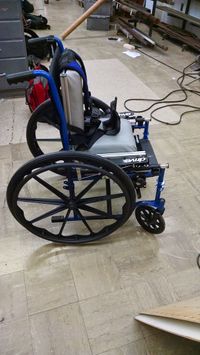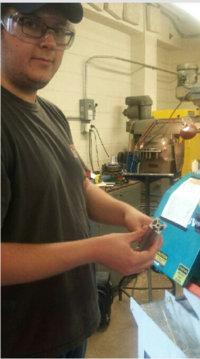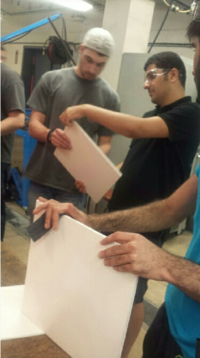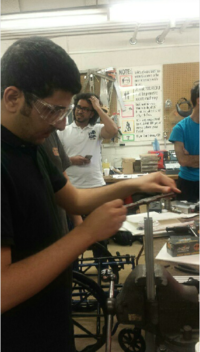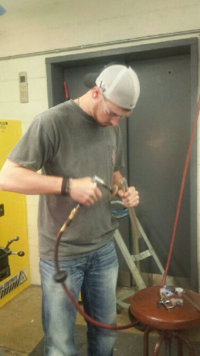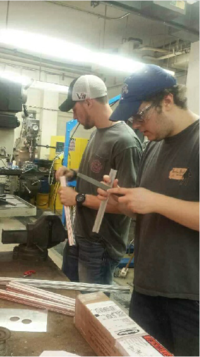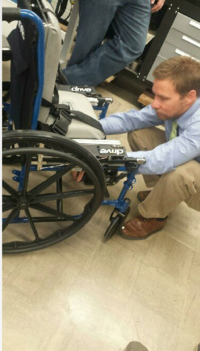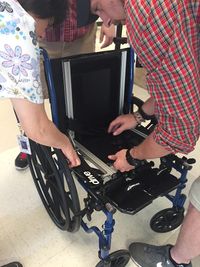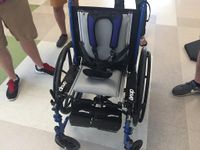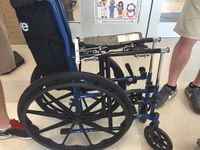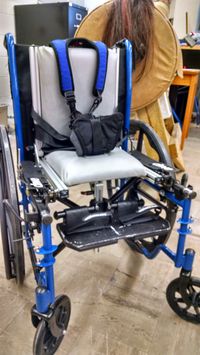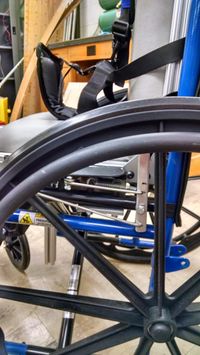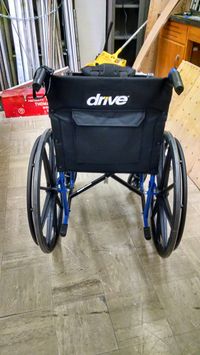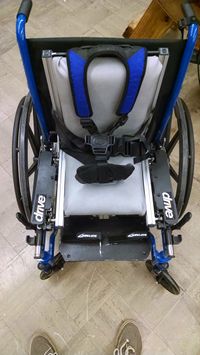Flexion State Wheelchair S15
Abstract
The child we are working with is a young boy, age 4, who is diagnosed with Spastic Cerebral Palsy. He needs a custom wheelchair that will keep his posture and leg joints at 90 degree angles to keep him from flexing out. The wheel chair will need to be able to be collapsible and compact. This will be the wheelchair that the boy uses for the next four to five years and , therefore, should be adjustable to accommodate his growth.
Team members
- Clayton Smith
- Faisal Almutairi
- Abdulhalim Alkateb
- Yousef Alkandari
- Fahad Alahazi
- Tyler Christian
- Acknowledge help of others
other
Problem Statement/overview of the need
The young child that we are working with is diagnosed with Spastic Cerebral Palsy and is in need of a custom wheel chair. His condition causes him to go into a flexion state where he straightens out like a board and is unable to stay in his seat. The only way to keep him from going into a flexion state is by keeping his joints in his hip, knees, and ankles at 90 degree angles. The seat he currently uses at school keeps him in that posture but it is not mobile. The custom wheelchair needs be collapsable so it will be easy to put away in a car while providing comfort to the child. The wheelchair needs to be adjustable since the child will most likely be using it for the next 5 years. It also needs to have straps to keep him sturdy in the wheelchair.
Design Specifications
1. Adjustable -Foot rests (adjustable up to 5 or 6 inches) -Side Braces (adjustable up to 5 or 6 inches) -Straps must be adjustable for comfort and support
2. Collapsable -Must be able to fold up easily for transport
3. Stability -Must be sturdy and reliable
4. Light Weight -Must be light enough to easily place in and out of a vehicle
5. Comfortable -Child will be restrained to this chair for long periods of time each day. Therefore, it needs to be padded and comfortable to sit in.
6. Restraining -Straps must restrain child in a flexion position
7. Child Specific Seat -Seat must meet child's joint to joint dimensions
Background research
1. Traditional Wheelchair This is the most common type of wheelchair and can be easily purchased. While this wheelchair provides a collapsable feature, it does not have straps that would provide support to stay in a flexion position. This wheelchair is adjustable in some aspects;however, it would not meet the specific dimensions for the child.
2.Flexion Chair This is the chair that the child sits in while he is at his desk at school. This chair is padded and has straps that restrain him from leaving a flexion state. On the down side, this chair is quite heavy and not mobile.
3.Specialized Wheelchair This wheelchair meets many of the groups design specifications. It provides straps, and it is also collapsable. However, in order to keep the child from going into a state of tension the dimensions need to be specific and all joints need to be kept at a 90 degree angle.
Conceptual Design
Summarize your conceptual design process. Develop at least three concepts.
Design Concept 1
- This is one of the most basic designs that was drawn during the conceptual design process. The seat and back rest is designed with hinges to fold up, allowing the wheelchair to be collapsable. The foot rest are also designed to be adjustable. This design lacks straps and braces to keep the child seated in the wheelchair.
- This design meets most of the design specifications;however, the over performance of this design after analyzing the needs of the child would be poor. Since the are no straps to provide support, there is nothing that would keep the child in the flexion state.
Design Concept 2
- This concept also is designed to use hinges in order to be collapsable. Instead of the seat breaking down, the seat would be hinged on one side, and on the other side the seat would rest on supports. The back rest is also designed to work the same way as the seat. There would be latches that secure the seat and back rest to keep them from folding at unwanted times. Although it is not shown on the drawing, this concept is also designed to have straps to restrain the child.
- This concept meets the design specifications, but only being hinged on side, the stability of the wheelchair may be compensated because of the way it collapses. Taking this into account, the supports for the seat will have to be able to withstand the force of the child.
Design Concept 3
- This concept, very similar to concept 1, is designed to use hinges and latches for the seat and back rest to fold up. It is also equipped with straps for support. The rest pads add support and keep the child from tipping side to side. This design is adjustable and collapsable for easy transport.
- This design has meets all of the design specifications but the performance of the wheelchair folding up may be poor due to the use of so many hinges.
Design Concept 4
- This concept is the design that best meets the design specifications and will be simple to operate. This design includes a chair that will be child specific and mount onto a pre-existing wheelchair. This seat will be easily removable for transport.
- This is the design that we have chosen to begin the steps of engineering analysis, price evaluation, and construction.
Evaluate concepts/select candidate
- Chart based on a 1 to 5 scale
| Adjustable | Collapsable | Stablitiy | Light Weight | Comfortable | Restraining | Total (Out of 30) | |
|---|---|---|---|---|---|---|---|
| Concept 1 | 3 | 3 | 4 | 4 | 5 | 1 | 20 |
| Concept 2 | 2 | 5 | 4 | 5 | 5 | 5 | 26 |
| Concept 3 | 4 | 3 | 4 | 4 | 5 | 5 | 24 |
| Concept 4 | 5 | 4 | 5 | 5 | 5 | 5 | 28 |
- The winning design is concept 4. This design from analysis will perform the best and meet the design specifications stated. This design is expected to have the best collapsibility and restraining factor. This preliminary design is going to be further analyzed for more adjustability.
Detailed Design
Description of selected design
The winning design is the 4th concept shown above in the sketch. The idea for this design is to take a prebuilt wheelchair and use the frame as a basis for our design. We will make a custom seat to fit the specific dimensions of the child. This seat will be a light-weight aluminum alloy that will also collapse and will latch into the frame of the wheelchair via bear claw latches similar to those on car doors. There will be a handle in the front of the seat that will allow the four latches to release easily. The seat will fold up with the use of a few hinges and pins. Two inch cushions will be added to the chair and also a system of straps will be added to keep the child in the desired posture. The straps include: a five point harness, a waist strap, a shin strap, and also velcro shoe straps.
Detailed description of selected design
This design will be constructed out of aluminum alloys. The wheelchair frame will be modified by welding an 8"x12"x1/8" plate to a support bar on the frame of the wheelchair. There will be one of these plates on each side of the wheelchair that will be adapt with holes for the pin/latch mechanism. The designed seat will be constructed of 1"x1" 6063 aluminum tubing and also 1/8" , 3/16" thick 6061 aluminum plates. Two 3/16" plates will be hinged to the bottom the seat and will be equipped with slots and bear claw latches what will allow the seat to be easily removed and secured. The latches will be released with a handle that will be placed towards the front-center of the seat. The back uses a hinge mechanism to fold down, while the legs of the seat will fold the opposite way. Adjustable lateral braces are in place on the vertical 1"x1" tubing of the seat to allow support. The five point harness will be attached to the back plate of the seat and the waist strap will be attached to the bottom plate. The shin straps will be mounted onto the same plate that the handle for the latches is secured on, and the velcro foot straps will be on the bottom foot rest plate. Two inches of cushion will be used for the back and seats and these will be secured with velcro for easy removal. After weight analysis, the seat itself will weigh approximately 16 lbs and the wheelchair and the seat combine will weigh approximately 60 lbs.
Revised Description of Selected Design
The revised design concept is very similar to the original selected design; however, the materials used in the revised design will make the overall weight less and will still be able to withstand the applied loadings. The material for the framing of the designed seat will be constructed from 1"x1" 80/20 Aluminum Alloy Extrusions. These extrusions will be assembled with the use T-nuts and other 80/20 compatible parts to keep from having to weld all pieces of the design. Furthermore, instead of using aluminum plates for the back support and seat support, a polyethylene plastic (HDPE) will be used to support the loadings. The plates that attach to the wheelchair frame will also be made of this high density plastic and the plates that originally were attached to the bottom of the seat where the pins would connect to the wheelchair frame have been removed all together. Also, four bear claw latches will be used instead of two. A handle will still be in place attached with a system of cables that will allow easy release of the latches. This design will still have a sound structure to hold the loadings and will be lighter. The weight for the revised design will be approximately 10 pounds.
Analysis
Engineering Analysis 1: shows that the plate used for the seat can support the weight of the child.
Engineering Analysis 2: shows that the pins used for the latching mechanism can support the weight of the child and the seat.
Engineering Analysis 3: shows the mobility for the seat and the wheelchair frame.
Engineering analysis 1
- This picture in enlarged to a scale of 202X magnification of the deflection; however, the deflection is minimal and the deflection is .026 inches which is only approximately 1/40 of an inch. Therefore, the 1/8" plate should be adequate to support the load.
- This the hand-worked analysis of the deflection of the plate. This number came out to be a little more but is still not a significant enough to permanently deform the plate or to cause the plate to fail.
Engineering analysis 2
- Since the stainless steal striker pin deforms an insignificant length, the bear claw latches with .5" striker pins will have no problem supporting the weight of the child and the seat combined.
Engineering analysis 3
Analysis for Revised Design
Engineering Analysis 4
Engineering Analysis 5
Engineering Analysis 6
CAD Drawings
CAD Drawings For Revised Design
Bill of Materials
| QUANTITY | ITEM | DESCRIPTION | SOURCE | PART # | PRICE (total for each line) |
|---|---|---|---|---|---|
| 1 | Blue Streak Wheelchair | Pediatric Wheelchair | Amazon.com | BLS20FBD-SF | $130.00 |
| 1 | 8' 80/20 Extrusion | 1"x1" T-Slotted Extrusion | Faztek.com | 10EX1010 | $24.25 |
| 1 | Locking Handle | Linear Bearing Break Kit | Faztek.com | 10LM8420 | $9.32 |
| 1 | Slider | Double Flange Linear Bearing 1" Ext. | Faztek.com | 10LM8440 | $35.54 |
| 2 | 2 Bear Claw Latches | Locking MIni Bear Claw Door Latch Set | Autoloc.com | AUTBCSM | $110.00 |
| 2 | Comfort Basic Foam | 2" Thick High Density Foam w/ Removable Cover | Comfort Company | 47/47V | 60.00 |
| 1 | 5-Point Harness | Baby 5-Point Harness For Stroller | Amazon.com | BOOMUITGLE | $14.78 |
| 2 | Waist Strap | 2" Nylon Buckle Strap | Strapworks.com | N/A | $12.98 |
| 1 | Velcro Straps | 12PK 11" Velcro Cable Straps (Black) | Amazon.com | N/A | $8.65 |
| 2 | Hinge Assembly | 1" LH 90 Deg. Pivot Assembly with L-Handle | Faztek.com | 10HI8353 | $51.50 |
| 1 | Hinge Assembly | 1" RH 90 Deg. Pivot Assembly with L-Handle | Faztek.com | 10HI8355 | $25.75 |
| 8 | Brackets | 1" Panel Retainer | Faztek.com | 10AC7810 | $30.48 |
| 2 | Cables | Odyssey Gyro G3 Upper Short Bike Detangler Cable(390 mm) | Amazon.com | N/A | $15.98 |
| 1 | HDPE Plates | 1/4" x 24" x 48" Polar White Seaboard | United States Plastic Corp. | 46054 | 31.39 |
| 5 | Bolts | 1/4-20x 1/2 Fbhscs Flanged Button Head | Faztek.com | 13FA3309 | $1.05 |
| 5 | Nuts | 1/4-20 Economy T-Nut | Faztek.com | 10FA3121 | $1.30 |
| 4 | Nuts | 1/4-20 Double Economy T-Nut | Faztek.com | 10FA3122 | $3.28 |
| TOTAL | $566.25 |
Assembly Instructions
The original seat and back rest where removed. Next, the latches were bolted onto the frame of the wheelchair. The T-slot extrusion was cut and assembled to form the seat, and then cushions were made to velcro for easy removal. Furthermore, straps were bolted on and the the padding that goes over these straps was added. The footrest was built using the previous wheelchair attachments but velcro straps were added to restrain the feet of the child. Next, a lever was mounted to the wheelchair that was spring loaded. From this lever, two rods were made to run to each latch. This allowed two latches to be unlocked simultaneously.Once of these levers was placed on each side of the wheelchair frame to account for all four latches. Finally, the seat was set into the frame to form the completion of the wheelchair.
Fabrication Process
Testing and implementation
To test the the safety of the wheelchair, a load of 200 pounds was applied to make sure that the pins would not break under the worst circumstances. Also, fine tuning of the latch releasing mechanism was done to ensure easy removal of the seat from the wheelchair. The wheelchair was delivered, and the child fit perfectly into the seat. The hope was that he would be able to push himself around in the chair; however, he is not quite big enough yet or strong enough to do so. Overall, the therapist seemed pleased with the design and delivery of the the final product.
Photos of Completed design
Instructions for safe use
Step 1: Unsnap 5-point harness and remove child
Step 2: Remove the cushions from the seat that are attached using Velcro
Step 3: Remove seat from wheelchair frame by using the lever rods on each side
Step 4: Loosen the handles on the seat to allow the seat to easily fold up. Once in the folded position, tighten the handles to ensure that the seat stays in the folded position.
Step 5: Pull up on the black support bar to collapse the frame of the wheelchair. Once the frame is collapsed, used the Velcro strap to ensure that the frame will stay in the storing position.
Do not use the device unless supervised by an adult that has been fully understood the safe use of this product.
Project Summary, Reflection
This wheelchair was designed to be collapsable and child specific. It met both of these specifications and the restraining straps held the child in the posture that was desired. Overall. the functionality of the wheelchair was sufficient and all design specifications were met. Reflecting on the wheelchair, it would be have been good if there was not so many steps in collapsing the wheelchair. Also, only having two latches instead of four would have made the removal of the seat from the frame easier.

